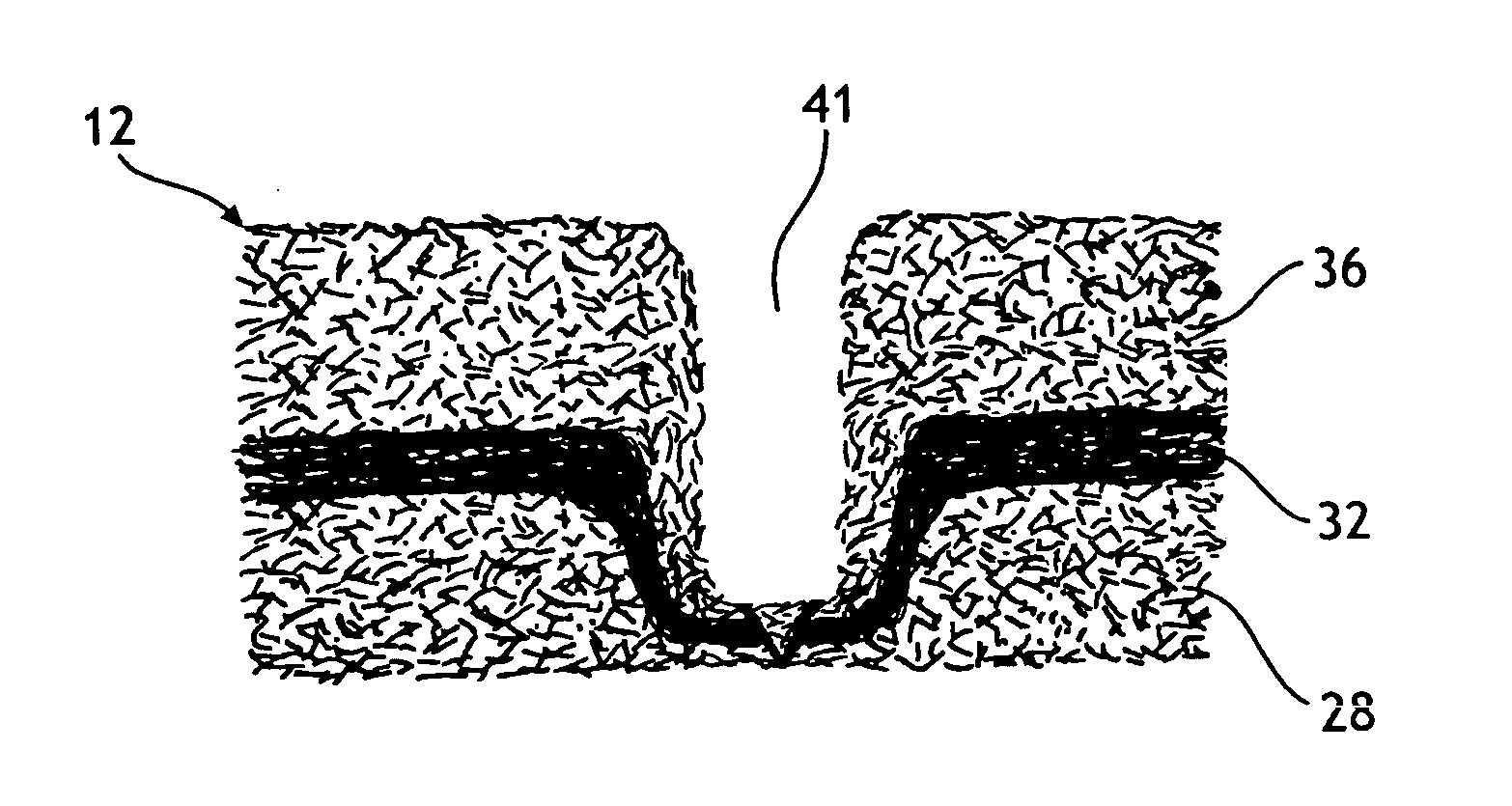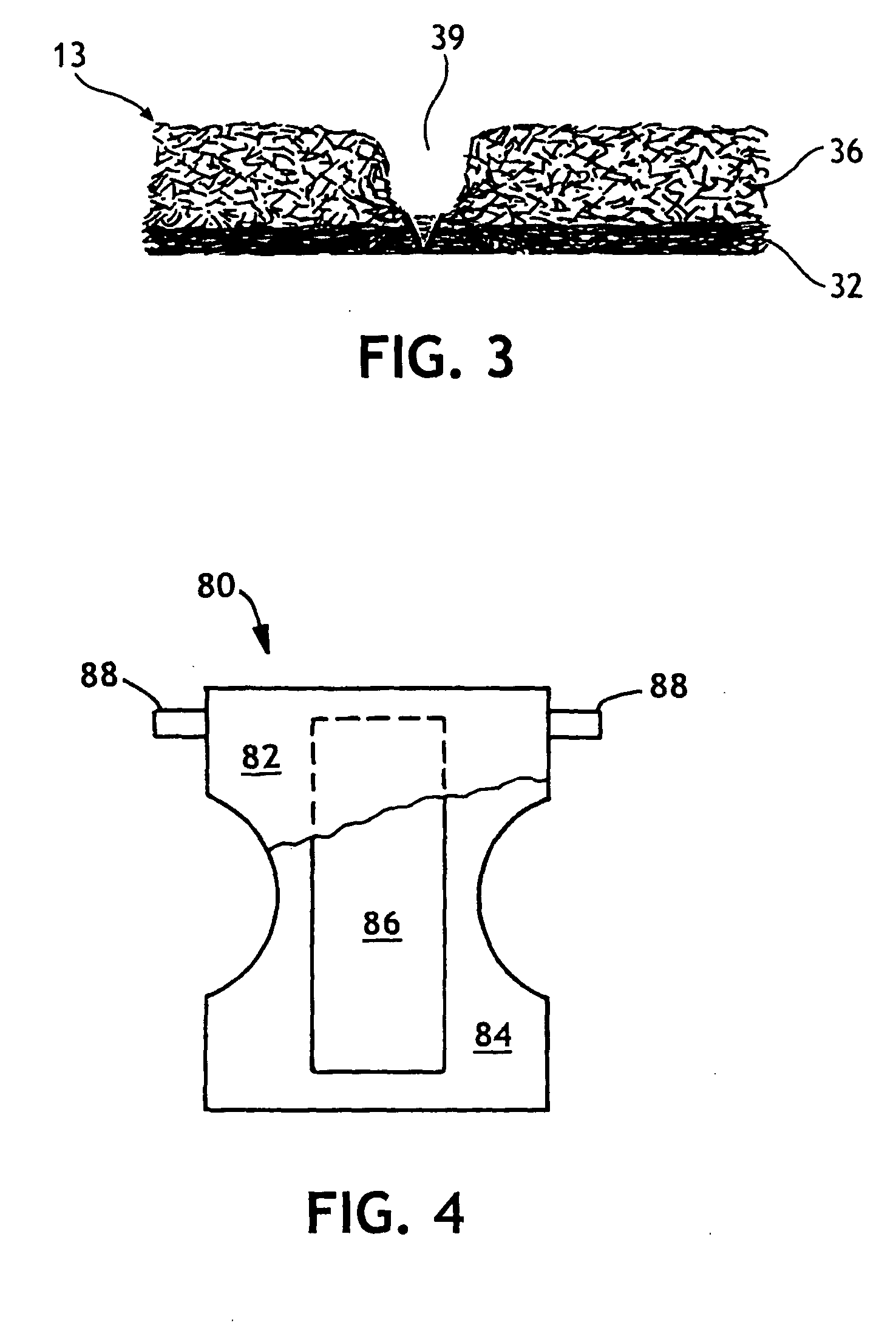Nonwoven fabric laminate that reduces particle migration
a nonwoven fabric and particle migration technology, applied in the field of nonwoven fabric laminates and absorbent articles, can solve the problems of inability to adequately contain superabsorbent particles, inconvenient, conventional absorbent articles,
- Summary
- Abstract
- Description
- Claims
- Application Information
AI Technical Summary
Benefits of technology
Problems solved by technology
Method used
Image
Examples
example 1
[0061] A SMS fabric laminate (80 percent SB and 20 percent MB) was produced by forming and laminating a first 0.14 (4.75 gsm) osy spunbond layer, a 0.07 osy (2.4 gsm) meltblown layer, and a second 0.14 osy spunbond layer at a line speed of about 1996 feet per minute (fpm). The SMS laminate having an overall basis weight 0.35 osy (1.9 gsm) was and was heated online with a Hot Air Knife (HAK) at 435° F. as described in U.S. Pat. No. 6,019,152 and then thermally bonded using a wire weave bond pattern. The SMS laminate was surface treated off-line with an aqueous treatment solution consisting of water and about 0.3 weight percent of a surfactant mixture that consisted of a mixture of AHCOVEL Base N-62 and GLUCOPON 220 UP surfactant at a 3:1 ratio based on a total weight of the surfactant mixture using the dip and squeeze method and targeting an 80 percent wet pick-up value.
[0062] The 0.35 osy laminate was tested using the SAM shake test. The 0.35 osy SMS laminate achieved a 99.6 percen...
example 2
[0063] A SMS fabric laminate (80 percent SB and 20 percent MB) was produced by forming and laminating a first 0.18 osy (6.1 gsm) spunbond layer, a 0.09 osy (3.0 gsm) meltblown layer, and a second 0.18 osy spunbond layer at a line speed of about 1843 fpm. The necked SMS laminate had an overall basis weight 0.45 osy (15.3 gsm). This SMS laminate was also surface treated with an aqueous treatment solution consisting of water and about 0.3 weight percent of a surfactant mixture that consisted of a mixture of AHCOVEL Base N-62 and GLUCOPON 220 UP surfactant at a 3:1 ratio based on a total weight of the surfactant mixture using the dip and squeeze method and targeting an 80 percent wet pick-up value.
[0064] The 0.45 osy laminate was tested using the SAM shake test. The 0.45 osy SMS laminate of Example 2 achieved a 100 percent SAM retention level using the SAM shake test. The 0.45 osy SMS laminate of Example 2 was also tested for Run-Off using the above-described procedure and measured 2.3...
example 3
[0065] A SMS fabric laminate (90 percent SB and 10 percent MB) was produced by forming and laminating a first 0.1575 osy (5.3 gsm) spunbond layer, a 0.035 osy (1.2 gsm) meltblown layer, and a second 0.1575 osy spunbond layer at a line speed of about 1996 fpm. The necked SMS laminate had an overall basis weight 0.35 osy (11.9 gsm). This SMS laminate of Example 3 was also surface treated with the same treatment solution using the dip and squeeze method at a targeting 80 percent wet pick-up.
[0066] The 0.35 osy laminate was tested using the SAM shake test. The 0.35 osy SMS laminate of Example 3 achieved a 98.8 percent SAM retention level using the SAM shake test. The 0.35 osy SMS laminate of Example 3 was also tested for Run-Off using the above-described procedure and measured 0.9 grams of run-off without the surge layer and 0.7 grams of run-off with the surge layer.
PUM
 Login to View More
Login to View More Abstract
Description
Claims
Application Information
 Login to View More
Login to View More - R&D
- Intellectual Property
- Life Sciences
- Materials
- Tech Scout
- Unparalleled Data Quality
- Higher Quality Content
- 60% Fewer Hallucinations
Browse by: Latest US Patents, China's latest patents, Technical Efficacy Thesaurus, Application Domain, Technology Topic, Popular Technical Reports.
© 2025 PatSnap. All rights reserved.Legal|Privacy policy|Modern Slavery Act Transparency Statement|Sitemap|About US| Contact US: help@patsnap.com



